
How to cleanse a mailing list
A clean and well-maintained mailing list is the backbone of a successful email marketing campaign, so it’s essential that you know how to cleanse a mailing list.
By regularly cleansing your mailing list, you can ensure that your messages reach engaged recipients, improve deliverability rates, and maximise the impact of your email campaigns. In this article, we will explore effective strategies and best practices to help you cleanse your mailing list and optimise its quality.
1. Review and Segment Your Mailing List:
Start by reviewing your mailing list to identify inactive or disengaged subscribers. Look for subscribers who haven’t opened or clicked on your emails in a significant period. Segment your list based on different criteria such as engagement levels, demographics, or purchase history. This segmentation will help you tailor your messages and target specific groups more effectively, ensuring higher engagement.
2. Remove Invalid and Inactive Email Addresses:
Identifying and eliminating invalid and inactive email addresses is crucial for list hygiene. These addresses can harm your sender reputation and impact deliverability rates. Consider using email verification tools that detect syntax errors, fake addresses, and inactive domains. Remove these addresses from your list to maintain a clean and accurate database.
To replace them, you can talk to a reputable data supplier like Results Driven Marketing 🙂
3. Deal with Bounces:
Bounced emails occur when messages fail to reach recipients’ inboxes. They can be classified as either “hard bounces” or “soft bounces.” Hard bounces are permanent delivery failures caused by factors like non-existent or blocked email addresses. Soft bounces are temporary issues such as full mailboxes or temporary delivery failures. Monitor bounce rates and remove email addresses that consistently result in hard bounces to maintain a healthy mailing list.
4. Encourage Subscribers to Update Information:
Provide an easy and accessible preference centre where subscribers can update their contact information. Encourage them to periodically review and modify their email addresses, preferences, or demographic details. This practice ensures that your messages reach the right recipients and reduces the chances of emails bouncing.
5. Honour Unsubscribe Requests Promptly:
Make it effortless for subscribers to unsubscribe from your list. Include a clear and visible unsubscribe option in all your emails. When recipients choose to opt out, honour their requests immediately. Promptly removing unsubscribed individuals from your list demonstrates respect for their preferences and helps maintain a positive brand image.
6. Monitor Engagement Metrics:
Engagement metrics such as open rates, click-through rates, and conversions provide valuable insights into the health of your mailing list. Regularly monitor these metrics to identify subscribers who consistently show low engagement. Consider re-engagement campaigns to win back their interest. If efforts fail, it may be appropriate to remove these subscribers from your list to maintain a highly engaged audience.
7. Follow Email Marketing Best Practices:
Adhering to email marketing best practices is vital for maintaining a clean mailing list. Some key practices to follow include:
a. Use Double Opt-In: Implement a double opt-in process to confirm the subscription of new subscribers. This process helps ensure that only genuine and interested individuals are added to your list.
b. Regularly Test Your Emails: Before sending out campaigns, perform thorough testing to ensure your emails render correctly across different devices, email clients, and web browsers. This practice helps maintain a professional appearance and a positive user experience.
c. Segment and Personalise: Tailor your email content based on subscribers’ preferences, demographics, or past interactions. Personalisation increases engagement and relevance, leading to better campaign results.
Conclusion:
Cleansing your mailing list is an ongoing process that requires consistent effort and attention to detail. By regularly reviewing, segmenting, and removing invalid or disengaged email addresses, you can maintain a clean and highly engaged audience. Following email marketing best practices and monitoring engagement metrics will help you optimise the quality of your mailing list and drive better results from your email marketing campaigns. Remember, a strong and healthy mailing list is the foundation of successful email marketing. It allows you to connect with your audience effectively and achieve your marketing goals. By implementing the strategies and best practices mentioned in this article, you can ensure that your mailing list remains clean, up-to-date, and engaged.
Remember, cleansing your mailing list is not a one-time task but an ongoing process. Set aside regular intervals to review and maintain your list, ensuring its accuracy and relevance. By doing so, you will maximise the deliverability of your emails, enhance engagement with your audience, and ultimately drive the success of your email marketing campaigns.
So, take the time to cleanse your mailing list today and enjoy the benefits of a well-maintained and highly engaged subscriber base.
Drop us a line today if you are interested in adding high quality information to your mailing lists





